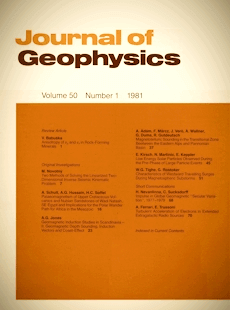Reflection and transmission of Love channel waves at coal seam discontinuities computed with a finite difference method
Article Sidebar

Vols. 1-18 (1924-1944), ISSN 0044-2801
Main Article Content
Abstract
Channel waves serve as a tool for the detection of discontinuities in coal seams caused, for example, by tectonic faulting. In this paper we study Love waves propagating along two-dimensional discontinuous coal seams. Synthetic seismograms, computed with an explicit finite difference method, are presented for three types of discontinuities: the seam end, the horizontal and the vertical offset. In all cases the discontinuity reflects mainly those waves with short wavelength and transmits those waves with large wavelength. An additional damping term is introduced into the finite difference formulation in order to prevent reflections from the edges of the computational grid. The boundary conditions at interfaces are all approximated with a truncation error of second order.
 ARK: https://n2t.net/ark:/88439/y000566
ARK: https://n2t.net/ark:/88439/y000566
Permalink: https://geophysicsjournal.com/article/170
Article Details
References
Alterman, Z., Loewenthal, D. (1972) Computer generated seismograms. In: Bolt, B., Alder, B., Fernbach, S., Rotenberg, M. (Eds.) Methods in computational physics, Vol. 12, Academic Press, New York
Boore, D.M. (1970) Love waves in nonuniform waveguides: finite difference calculations. J. Geophys. Res. 75:1512-1527
Boore, D.M. (1972) Finite difference methods for seismic wave propagation in heterogeneous materials. In: Alder, B., Fernbach, S., Rotenberg, M. (Eds.) Methods in computational physics, Vol. 11, Academic Press, New York
Clayton, R., Engquist, B. (1977) Absorbing boundary conditions for acoustic and elastic wave equations. Bull. Seismol. Soc. Am. 67:1529-1540
Dresen, L., Freystatter, S. (1976) Rayleigh channel waves for the in-seam seismic detection of discontinuities. J. Geophys. 42:111-129
Freystatter, S., Dresen, L. (1978) The influence of oblique-dipping discontinuities on the use of Rayleigh channel waves for the in-seam seismic reflection method. Geophys. Prosp. 26:1-15
Kelly, K.R., Ward, R.W., Treitel, S., Alford, R.M. (1976) Synthetic seismograms: a finite difference approach. Geophysics 41:2-27
Krey, T.C. (1963) Channel waves as a tool of applied geophysics in coal mining. Geophysics 28:701-714
Mitchell, A.R. (1969) Computational methods in partial differential equations. J. Wiley, New York
Reynolds, A.C. (1978) Boundary conditions for the numerical solution of wave propagation problems. Geophysics 43:1099-1110
Smith, W.D. (1974) A nonreflecting plane boundary for wave propagation problems. J. Comp. Phys. 15:492-508











